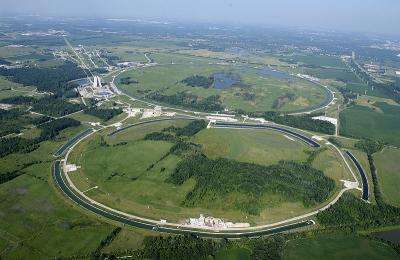January 11, 2011 report
Tevatron atom smasher to close in September

(PhysOrg.com) -- The 25-year-old Tevatron particle accelerator in the US will end its operations in September this year since no funds are available to extend its life for three more years.
The Tevatron is located at the Fermi National Accelerator Laboratory (Fermilab) in Batavia, Illinois, and accelerates and collides protons and antiprotons traveling around a four-mile loop at almost the speed of light. The results of the collisions enable researchers to study the structure of matter.
Scientists working with the Tevatron had hoped it would be able to keep running for another three years, giving them the chance to find the Higgs boson (also known as the “God particle”) before their European counterparts using the much newer 17-mile loop Large Hadron Collider (LHC). Now they have been told the funds are not available.
The Higgs boson is of extreme importance to the Standard Model, the most widely accepted theory of physics, since the theory predicts its existence to explain how most of the known elementary particles gain mass. Scientists have been trying to detect it for decades, so far without success.
The Tevatron is funded by the US Department of Energy (DOE) and an additional $35 million is required each year to keep it operating. DOE Office of Science head William Brinkman has written to Fermilab, via the DOE High Energy Physics Advisory Panel, to say that the current challenging budgetary climate means the additional funding is not available. The Tevatron will therefore cease operations in September as originally scheduled.
The Fermilab scientists, led by Pier Oddone, had hoped the Tevatron could remain in operation to allow them to take advantage of the planned 2012 or 2013 closure of the LHC, which might have given them the chance to be first to spot the Higgs boson. The scientific advisory panel at Fermilab recommended in August that Tevatron should be kept running to 2014 despite the cost, but Oddone calculated only $15 million could be made available from the lab’s budget by delaying other projects but the additional $35 million would need to come from DOE. DOE approved the plan, provided funds were available, but have now announced they are not.
Many physicists say the Tevatron is more likely to find the Higgs boson because it has lower energy and cleaner collisions and the Higgs is thought to have a mass about 121-144 times that of a proton. The Tevatron may also be more suitable because its collisions are between protons and antiprotons, while the LHC collides protons and protons, so the Tevatron can probe connections between new particles and other particles that cannot be probed with the LHC.
Dr. Oddone said the Tevatron had exceeded all original expectations and had been involved in a number of historic discoveries. Scientists working on the Tevatron will be moved to other projects and will continue to collaborate with CERN, which operates the LHC, but the future of the people involved in operating the Tevatron is not yet known.
© 2010 PhysOrg.com


















